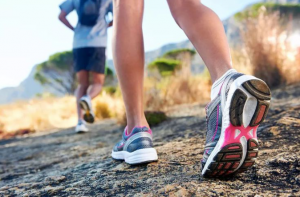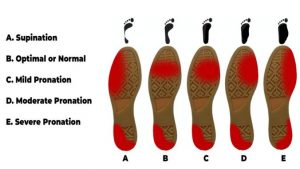Supination means that the way your feet touch the ground will tilt your feet outward. However, a suitable pair of running shoes can help you effectively prevent pain and injury.
Simply put, running is to alternately place one foot in front of the other. But the way your feet touch the ground may make running less easy.
Ideally, when running, your weight is evenly distributed and your feet are on the ground with your midfoot. This is called normal internal rotation. Since your ankle and leg are aligned correctly, the risk of injury is reduced. In addition, the weight distribution is even, which can better slow down the impact of the feet when they hit the ground.
Both external and internal foot rotation affect your gait and coordination.
Pronation of the foot (to be precise, excessive pronation) means that the feet are tilted excessively inward, which distributes more bodyweight on the foot and the inside of the arch.
Supination of the foot (also known as insufficient internal rotation) causes the feet to tilt outward, and the bodyweight is distributed on the outer edges of the feet and ankles. This can cause ankle pain, plantar fasciitis, shin splint pain, sprains, and iliotibial band pain.
There are many complicated reasons for the supination of the foot. For example, you may inherit a foot structure that is prone to insufficient internal rotation, such as a naturally high arch or inflexible instep. Another common cause of supination of the foot is overuse of the feet, ankles, or legs, injuries, or muscle imbalances.
If this suits your situation, the effective way to correct excessive supination is to wear suitable shoes. Shoes suitable for correcting supination of the foot should have sufficient cushioning performance, good arch support effect, and a wide toe cap, to help support the foot, strengthen the internal rotation of the foot and reduce the impact of the cushion.

What are the key characteristics of running shoes suitable for supination?
1. Comfortable fit
This seems to be taken for granted, but only choosing a shoe size that is suitable for both length and width can help strengthen pronation. If the running shoes are too small or too large (too narrow or too wide), they will increase the natural supination of the feet.
2. Sufficient cushioning
High arches cannot absorb the impact from the ground, so it is important to choose running shoes with sufficient cushioning. Because people with supination usually touch the ground with the heel before the toes, it is recommended to choose running shoes with enhanced cushioning at the heel to help improve gait and reduce the impact on the heel.
However, too much cushioning may cause counter-effects and weaken the energy return of the next step. In other words, you can choose running shoes equipped with Nike React foam technology. This is the best of both worlds. It has excellent cushioning performance and is suitable for people with supination. This foam is soft, firm, and elastic. Its advantage is that it can absorb the impact from the ground and convert it into full energy feedback.
3. Wide toe cap
Every time you take a step, your externally rotated feet and toes need space to stretch. The narrow forefoot will restrict your feet and aggravate the injury caused by the supination of the foot, so you should give priority to shoes with a wider toe.
Reserving more space for the toes can also help prevent plantar fasciitis, a common symptom of people with supination of the foot.

4. Arch support
For people who are born with high arches, you can choose running shoes with a midfoot support design to make up for the lack of internal rotation. Wearing shoes without arch support may lead to supination of the foot.
Choose mid-foot shoes with sufficient cushioning and stability, such as running shoes equipped with Nike ZoomX foam. The foam adopts the shape of an “arc rocker”, which brings outstanding supporting effect to the three stages of running action. Let you enjoy the flexibility and flexibility when your feet are off the ground, the smooth experience when you step forward, and the excellent cushioning effect when you land. This midfoot arch support design can counteract the effects of high arches and help both feet to land close enough to the middle.
5. Ankle support and stability
Supination of the foot can cause excessive pressure on the plantar fascia and cause plantar fasciitis. Choose running shoes with excellent stability and support, which can help prevent this and other types of ankle injuries.
6. Soft feet
Supination runners need a pair of running shoes that provide a soft foot feel. People who are born with high arches may not be able to feel the ground strength feedback when running, especially when you are not wearing shoes with rebound and cushioning properties.
How to correct supination of the foot while running
1. Practice the correct running posture
Practicing the correct running posture is essential for correcting the supination of the foot. You may not have noticed that the natural high arch makes you accustomed to landing on the outside of your foot. Try to deliberately touch the ground with the soles of your feet every time you take a step so that the heel and toes transition smoothly. It may feel uncomfortable at first, but after deliberate practice, it will become more and more natural.

If the supination of the foot is severe, some exercises and stretching can help improve your gait. Depending on the severity of the problem, it can be assisted by a physical therapist or alone.
Achilles tendon stretching is a good choice.
Stand up straight with your legs hip-width apart.
Keep the toes of one foot off the floor, and only let the heel touch the ground, with the toes facing up.
Bend the other leg to deepen the stretch.
Your Achilles tendon and calf should feel stretched.
Supination of the foot usually causes tension in the Achilles tendon and calf, and this stretching can help correct the supination.
2. Wear ankle protectors
Wearing an ankle sheath can effectively reduce the risk of ankle joint injury common to people with external foot rotation. Ankle guards provide support for the ankle and reduce swelling and inflammation. In severe cases, the podiatrist may also recommend orthopedic braces.
3. Pay attention to the wear of shoes
According to general experience, you should replace running shoes every six months or when you notice signs of wear on the soles. When the soles begin to wear, the shoes will not be able to provide the required support and will increase supination.
